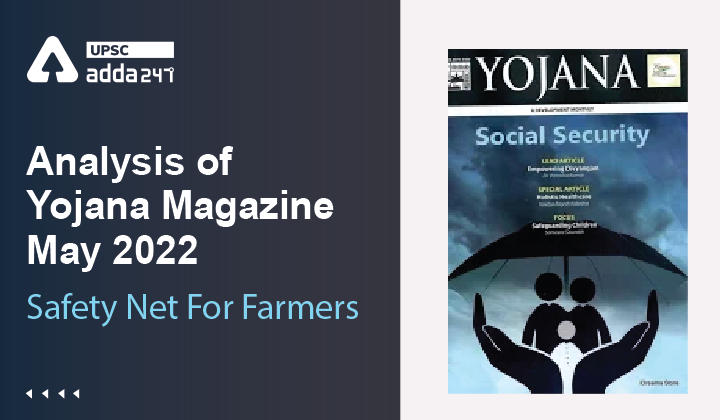Table of Contents
Analysis Of Yojana Magazine
”Safety Net For Farmers”
Introduction
- Agriculture is the mainstay of Indian economy accounting for primary livelihood of approximately 52 Per Cent Population and a chief source of raw materials for many major industries.
- Small farmers are generally economically impoverished, earning only 39 % of what medium holders earn, and only 13% of what large holders earn, hence it is of great need to formulate specific schemes for small and marginal farmers.
What is social protection?
- Social protection programmes fall into three main categories. These are social assistance: publically-provided non-contributory transfers that can be provided in kind (such as food) as well as cash; social insurance: pooled, contributory insurance programmes and labour market protection: provision of unemployment benefits, building skills and enhancing workers’ productivity and employability.
- A great diversity underlines the various types of social protection programmes found across and even within countries around the world. Typically, there are diverse sets of social protection programmes with different objectives, thus reflecting different contexts and preferences.
Minimum Support Price, Food Procurement Policy, and The PDS System
MSP
- Foodgrains are procured at the MSP fixed by the government mostly in a small number of grain-surplus States in the north of India, which are then transported across the country to deficit States (the latter mostly in the south and west of the country).
- MSPs are fixed on rates recommended by the Commission for Agricultural Costs and Prices (CACP), which are set using mainly the cost of cultivation. These grain stocks essentially supply the PDS of the country. Through the PDS, cereals are made available to BPL households, as well as to Above Poverty Line (APL) households—at differential prices.
- There is a third category of beneficiaries— Antyodaya cardholders. Under the Antyodaya Anna Yojana (AAY).
Procurement Policy
- The State Governments procure, store, and distribute foodgrains under Targeted Public Distribution System (TDPS) and other welfare schemes.
- In the event of the total quantity of wheat and rice thus procured falling short of the total allocation made by the Central Government, FCI meets the deficit out of the Central Pool stocks.
- Under this scheme, State-specific economic cost is determined by the GoI and the difference between the economic cost so fixed and the central issue prices (CIP) is passed on to the State as food subsidy.
Public Distribution System
- The PDS is a major State intervention in the country aimed at ensuring food security to all the people, especially the poor.
- The PDS operates through a large distribution network of around 4.89 lakh fair price shops (FPS), and is supplemental in nature.
- Under the PDS, the Central Government is responsible for the procurement and transportation of foodgrains up to the principal distribution centres of the FCI while the State Governments are responsible for the identification of families living below the poverty line.
Deendayal Antyodaya Yojana – National Rural Livelihoods Mission (DAY-NRLM)
- Launched in 2011, the Deendayal Antyodaya Yojana – National Rural Livelihoods Mission (DAY-NRLM) aims at mobilizing about 9-10 crore rural poor households into Self Help Groups (SHGs) in a phased manner and provide them long-term support such that they diversify their livelihoods, improve their incomes and quality of life.
Pradhan Mantri Fasal Bima Yojana (PMFBY)/ Restructured Weather Based Crop Insurance Scheme (RWBCIS)
- Pradhan Mantri Fasal Bima Yojana (PMFBY) & Restructured Weather Based Crop Insurance Scheme (RWBCIS) were launched from Kharif 2016 to provide comprehensive crop insurance coverage from pre-sowing to post harvest losses against non-preventable natural risks.
- These schemes are only risk mitigation tools available to farmers at extremely low premium rates payable by farmers at 2% for Kharif crops, 1.5% for Rabi Crop and 5% for annual commercial/horticultural crops.
- The balance of actuarial premium is shared by the Central and State Governments on 50 : 50 basis.
- The schemes are voluntary for States and available in areas and crops that are notified by the State Governments. Further, the schemes are compulsory for loanee farmers and voluntary for non-loanee farmers.
Interest Subvention Scheme (ISS)
- The Government provides interest subvention of 3% on short-term crop loans up to Rs.3.00 lakh. Presently, loan is available to farmers at an interest rate of 7% per annum, which gets reduced to 4% on prompt repayment.
- Further, under Interest Subvention Scheme 2016-17, in order to provide relief to the farmers on occurrence of natural calamities, the interest subvention of 2% shall continue to be available to banks for the first year on the restructured amount.
- In order to discourage distress sale by farmers and to encourage them to store their produce in warehouses against negotiable warehouse receipts, the benefit of interest subvention will be available.
PM-KISAN Scheme
Conclusion
Presently the approach of the Government of India has shifted from production centric to income centric platform in the agriculture sector and the above schemes are being implemented for making farming viable.



 TSPSC Group 1 Question Paper 2024, Downl...
TSPSC Group 1 Question Paper 2024, Downl...
 TSPSC Group 1 Answer key 2024 Out, Downl...
TSPSC Group 1 Answer key 2024 Out, Downl...
 UPSC Prelims 2024 Question Paper, Downlo...
UPSC Prelims 2024 Question Paper, Downlo...
